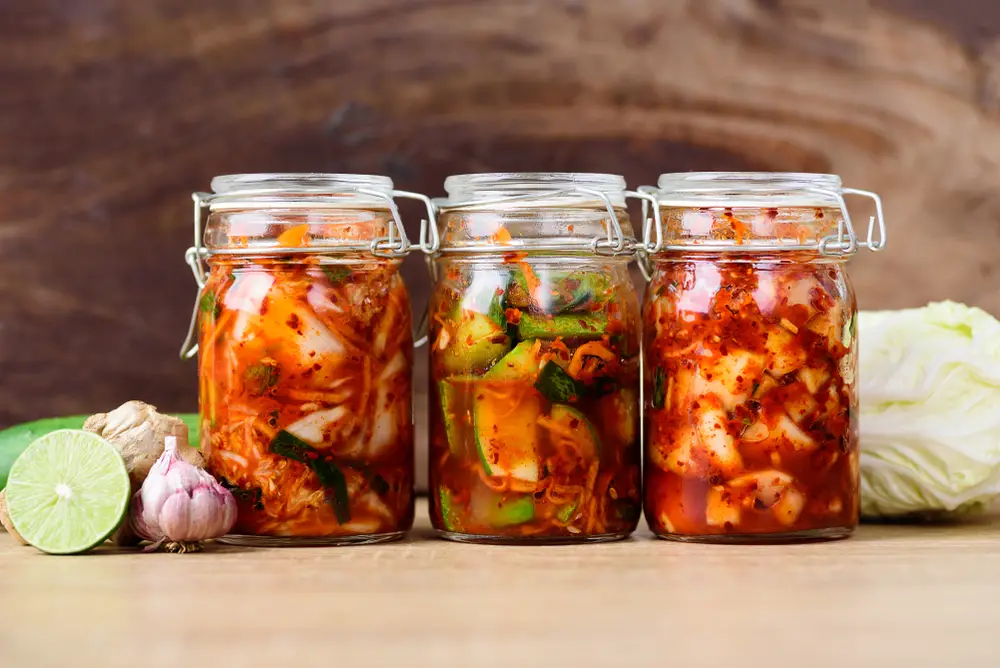Kimchi, a staple in Korean meals for hundreds of years, is a classic fermented side dish crafted from assorted vegetables and flavorful condiments.
While its roots lie in Korean culinary tradition, its global reputation is burgeoning. This rise in popularity is largely due to the numerous health benefits of kimchi, including enhanced digestion, inflammation control, and immune system fortification.
Recent investigations have unveiled more benefits, such as its role in tackling stubborn body fat and mitigating neuroinflammation in the brain.
Scientific Studies on Kimchi’s Health Potential
In a pioneering study, scientists explored the impact of kimchi on body fat. They discovered that it curtails the levels of stubborn fat in the body, including visceral and subcutaneous fat, as well as total cholesterol. The study also indicated that kimchi could diminish inflammatory markers in the body, like C-reactive protein. [1]
Hence, the researchers inferred that kimchi could serve as an effective dietary intervention for managing stubborn fat, particularly for individuals grappling with obesity and metabolic syndrome.
Moreover, kimchi is credited with the potential to alleviate neuroinflammation in the brain. Neuroinflammation refers to the inflammation of the nervous system, a condition tied to various neurological disorders, including Alzheimer’s disease, Parkinson’s disease, and multiple sclerosis. A groundbreaking study revealed that kimchi could favorably influence neuroinflammation in mice, demonstrating it could lower the brain’s inflammatory markers, such as interleukin-6. [2]

Nutritional Properties and Benefits of Kimchi
Evidence-based research suggests that kimchi’s neuroinflammation reduction properties can assist individuals with an array of conditions, such as:
- Alzheimer’s disease
- Parkinson’s disease
- Multiple sclerosis
- Amyotrophic lateral sclerosis
- Huntington’s disease
- Stroke
- Traumatic brain injury
- Autism
- Multiple system atrophy
- Tourette’s syndrome
Beyond these considerable health benefits, kimchi is an exceptional source of dietary fiber, essential vitamins, and minerals. It also boasts a high probiotic content, which refers to beneficial bacteria that encourage a robust gut microbiome. These probiotics can facilitate improved digestion and nutrient absorption, mitigate inflammation, and fortify immunity. [3]
Kimchi also contains bacteria of the Bacillus species, which produce proteases, lipases, and amylases. These enzymes digest proteins, fats, and carbs, respectively. Consuming kimchi daily eliminates the need to take additional digestive enzymes, but if kimchi isn’t a staple in your diet, like so many of my patients — I recommend taking a daily Digestive Enzyme to support your gut health.
Easy Way to Make Kimchi at Home
Kimchi is a flavorful, nutrient-rich, and adaptable side dish boasting a plethora of potential health benefits. Given its high fiber, vitamin, mineral, and probiotic content, this Korean staple is a commendable addition to any dietary regimen. For all these compelling reasons, consider incorporating kimchi into your meals for a healthy and delicious twist.
Thinking about adding Kimchi to your diet? Try our simple recipe:
Simple Kimchi Recipe
Ingredients:
- 1 medium-sized napa cabbage (about 2 pounds)
- 1/4 cup sea salt or kosher salt (non-iodized)
- Water
- 1 tablespoon grated garlic (5-6 cloves)
- 1 teaspoon grated ginger
- 1 teaspoon granulated sugar
- 2-3 tablespoons seafood flavor (or 2-3 tablespoons of water from soaked kelp)
- 1-5 tablespoons Korean red pepper flakes (gochugaru) depending on your preferred spice level
- 8 ounces radish, peeled and cut into matchsticks
- 4 scallions, trimmed and cut into 1-inch pieces
Instructions:
- Salting the cabbage: Cut the cabbage lengthwise into quarters, remove the cores, then cut each quarter crosswise into 2-inch-wide pieces. Place the cabbage and salt in a large bowl. Massage the salt into the cabbage until it starts to soften a bit. Then add water to the bowl until the cabbage is just covered. Let it sit at room temperature for at least 2 hours and up to 12 hours.
- Preparing the paste: While the cabbage is soaking, prepare the paste. Combine the garlic, ginger, sugar, and seafood flavor (or water) in a small bowl and mix to form a smooth paste. Mix in the gochugaru, using 1 tablespoon for mild and up to 5 tablespoons for spicy (adjust to your preference).
- Rinsing and draining the cabbage: Once the cabbage has finished soaking, drain and rinse it under cold water. Gently squeeze out the excess liquid and transfer it to a large mixing bowl. Add the radish, scallions, and paste to the bowl.
- Mixing the vegetables and paste: Now, it’s time to get your hands dirty! Gently work the paste into the vegetables with your hands until they are thoroughly coated.
- Packing the kimchi into the jar: Pack the kimchi into a clean 1-quart jar. Press down on the kimchi until the brine rises to cover the vegetables, leaving at least 1 inch of space at the top. Seal the jar with the lid.
- Fermentation: Let the jar stand at room temperature for 1 to 5 days. You may see bubbles inside the jar, and brine may seep out of the lid; place a bowl or plate under the jar to help catch any overflow.
- Checking the kimchi: Check it daily and refrigerate when it tastes ripe to you. Depending on your climate and your home’s temperature, the kimchi could be ready in just one day, or it could take several. Once it tastes to your liking, store in the refrigerator. It will continue to ferment slowly and become more tangy.
Enjoy your homemade kimchi as a side dish, in fried rice, or in a variety of other dishes. To expand your repertoire of healthy kimchi recipes, check out my comprehensive Superfood Cookbook. Start exploring the world of kimchi today and unlock a world of vibrant flavors and nourishment!

My Personal RX on Nourishing the Gut-Brain Axis Through Diet
- Incorporate Kimchi Into Your Daily Meals: Enjoying kimchi regularly can help manage stubborn body fat and mitigate neuroinflammation. It also supports gut health, aids in digestion, and fortifies the immune system. The recipe provided above is a simple and delicious way to start.
- Prioritize Plant-Based Fibers: A diet high in diverse fibers from vegetables, fruits, and whole grains nurtures gut microbiota diversity, which is linked to improved brain health and mood regulation.
- Download My Superfoods Cookbook: For more healthy recipes incorporating kimchi and other beneficial foods, download my Superfoods Cookbook. It’s packed with tasty, nutritious recipes that support overall health.
- Reduce Sugar and Processed Foods: Minimizing sugar and processed foods helps to avoid spikes in blood glucose and inflammation, which can disrupt both gut and brain health.
- Stay Hydrated: Drinking enough water is essential for the digestion and absorption of nutrients that support brain function and gut health.
- Increase Omega-3 Fatty Acids: Foods rich in omega-3s, such as salmon, flaxseeds, and walnuts, support both brain function and a healthy gut lining. They reduce inflammation, which is crucial for maintaining the integrity of both systems.
- Integrate MindBiotic into Your Routine: MindBiotic uniquely supports the gut-brain axis with its blend of probiotics, prebiotics, and Ashwagandha. This supplement is crafted to improve mental clarity and digestive health simultaneously. Including it in your daily regimen can be a powerful step towards holistic well-being.
- Explore How to ‘Heal Your Gut, Save Your Brain’: My upcoming e-book is a vital resource for anyone looking to delve deeper into the gut-brain connection. It explains the underlying science and offers a comprehensive guide to nurturing both mental and digestive health through holistic approaches.
Remember, food is not just fuel. It’s medicine. By making smart dietary choices and incorporating beneficial supplements where needed, you can greatly improve your health and quality of life.

Sources:
- Kim EK, An SY, Lee MS, et al. Fermented kimchi reduces body weight and improves metabolic parameters in overweight and obese patients. Nutr Res. 2011;31(6):436-443. doi:10.1016/j.nutres.2011.05.011 https://pubmed.ncbi.nlm.nih.gov/21745625/
- Kim N, Lee J, Song HS, et al. Kimchi intake alleviates obesity-induced neuroinflammation by modulating the gut-brain axis. Food Res Int. 2022;158:111533. doi:10.1016/j.foodres.2022.111533 https://www.ncbi.nlm.nih.gov/pmc/articles/PMC3598433/
- Park KY, Jeong JK, Lee YE, Daily JW 3rd. Health benefits of kimchi (Korean fermented vegetables) as a probiotic food. J Med Food. 2014;17(1):6-20. doi:10.1089/jmf.2013.3083
- Kimchi: Health Benefits, Nutrition, and How to Make It”. Healthline. Retrieved 10 May 2021., https://www.healthline.com/nutrition/benefits-of-kimchi




















